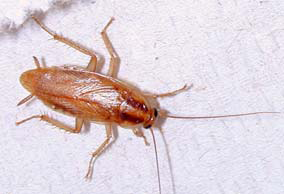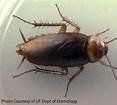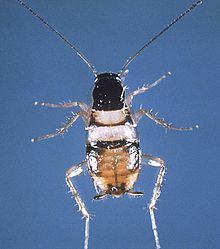Cockroaches and Schools
On this page:
Overview and Life Cycle
The basics: Cockroaches have six legs, wings, and antenna. They can run up to three miles an hour, and have been around since the dinosaurs. They range in size and color, and their shed skin contains allergens that can cause asthma. Below, we have focused on three of the most common cockroaches:
German Cockroach: Blattella germanica.

Photo Credit: Dini Miller, Virginia Tech
German cockroaches are the most common cockroach found in the United States. The German cockroach is:
- 12 to 17 mm (1/2 to 5/8 inch) long;
- tan to light brown; and
- has two dark brown stripes on the body region (pronotal shield) just behind the head.
Females will produce four to eight egg capsules during their lifetime, with each capsule containing approximately 40 eggs. The egg capsule is retained by the female until the eggs are ready to hatch, usually in 28 to 30 days.
German cockroaches are widespread and can be found in many indoor environments. Within these areas, the cockroaches prefer sites close to moisture and food, making them common pests in:
- Kitchens.
- Bathrooms.
- Food-storage areas.
More about the German Cockroach. Exit
School IPM for German Cockroaches Exit This page shows how to identify cockroaches and provides general information regarding them as well as chemical and nonchemical ways to control a cockroach infestation.
American Cockroach: Periplaneta Americana.
 American Cockroach
American CockroachPhoto Credit: University of Florida
The American cockroach is one of the largest cockroaches in the Northeast.
- It is about 40 mm (1.5 inches) long with a reddish-brown body.
- The center portion of the pronotal shield is light brown, while the outer edges are yellow.
Life Cycle: The female American cockroach will not retain the egg capsule for more than a day after its formation, instead dropping the capsule in some suitable site. Under some conditions it may be glued to a surface. The number of capsules produced by a female will range from 6 to 14, with each capsule containing 14 to 16 eggs. The eggs hatch in 50 to 55 days.
The American cockroach prefers dark, moist sites where it feeds on decaying organic matter. Such sites include:
- Basements.
- Kitchens.
- Clothes hampers.
- Drains.
- Bathroom plumbing or sewers.
Resources:
More about the American Cockroach and IPM. Exit
Brownbanded Cockroach: Supella longipalpa.

Photo Credit: CDC
The brownbanded cockroach is:
- 12 mm (1/2 inch) long;
- light brown; and
- has two lighter colored bands running across the body.
These bands are located at the base of the wings and on the abdomen. The bands are much darker during the immature stages.
Life Cycle: The brownbanded female carries the egg capsule for 24 to 48 hours before gluing it to a surface. The capsule contains approximately 18 eggs that hatch in 50-74 days. An adult female produces about 18 egg capsules over a life-span of 10 months.
The brownbanded cockroach requires less moisture than other cockroaches. It is more prevalent in homes, apartments, hotels and hospital rooms than in restaurants or stores. Evidence of this cockroach may be found:
- Behind pictures.
- In furniture.
- The underside of chairs and tables.
- In upper kitchen cabinets.
- On the upper shelves of closets and pantries.
Resources:
More information about brownbanded cockroaches. Exit
Health Concerns
Cockroaches and their droppings may trigger an asthma attack. Their feces, saliva, eggs, and outer covering, or cuticles left behind on surfaces contain substances that are allergenic to humans, especially those with asthma or other respiratory conditions.
Within and on the surface of their bodies, cockroaches carry bacteria that can cause salmonella, staphlylococcus and streptococus if deposited in food. Additionally, cockroach feces, skin sheddings and saliva can cause asthma and allergies, especially in children.
Read more about cockroach allergens:
- Cockroach Allergens Have Greatest Impact on Childhood Asthma In Many U.S. Cities National Institute for Environmental Health Sciences.
- Cockroach Allergy Exit Asthma and Allergy Foundation of America.
Cockroach Management Tips
To keep students and staff healthy, IPM helps schools stay free of cockroach infestations:
- Don’t allow dirty dishes to accumulate in the sink and remain there overnight.
- Keep food scraps in the refrigerator or in containers with tight-fitting lids.
- If small animals are in the classroom, keep the food in tightly sealed containers, and do not allow food to remain in the bowls overnight.
- Feed only what the animal will eat at the time of feeding.
- Remove garbage from the classroom and kitchen areas on a routine basis.
- o Keep outside containers covered, especially at night.
- Periodically check and clean the evaporation pan under the refrigerator or freezer.
- Check the critical area between the stove and cabinet where grease and food scraps often accumulate.
- Pull the stove out periodically and clean thoroughly.
Fact Sheets and Other Resources
A 2-page fact sheet on Cockroaches and School IPM (PDF) (2 pp, 73 K, About PDF) Exitfrom the California's Department of Pesticide Regulation.
